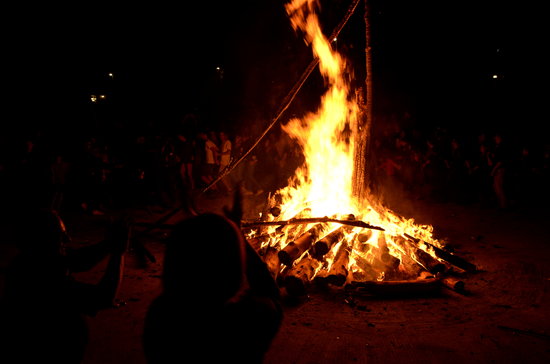The Night of Fire: Catalonia’s Sant Joan approaches
Held on June 23 and 24, one of the biggest celebrations in the country heralds the changing of seasons with many traditions

Sant Joan, coming up this Sunday, and Sant Joan’s eve, the night before is best known as a celebration of fire: bonfires, fireworks, correfocs, and solemn torches lit from a flame that never goes out.
It closely coincides with the Summer Solstice or Midsummer Night, celebrated all over the world and for thousands of years with flames to usher in a new season, symbolizing purity and cleansing.
Bonfires, or ‘fogueres,’ are lit throughout the city (in contained, safe areas), as well as on the beach, gathering crowds around them.
With a crack and a bang
This is also when everyone enjoys the fireworks, which suddenly become readily available. Smaller ones are set throughout the city for days before and especially after sundown, including flares, bangers, airbombs, roman candles, black cats, catherine wheels, snaps and all kinds more.
In fact, this is an important day for Catalonia’s firework sector. This year, the association representing Catalonia’s firework makers and retailers projects sales similar to 2017. The organization estimates that the public will again spend around 18 million euros on fireworks. Some shops even report an improvement in sales compared to last year, with the average household expected to spend around 40 euros on fireworks.
People also gather on balconies and rooftops to watch the display. If not, events take place in squares, often involving ‘correfocs,’ or ‘fire-runners,’ people dressed as devils brandishing torches spewing fireworks and sparks.
The Flame of Canigó
A more solemn occasion comes earlier, before the sun goes down. This is the Flama de Canigó, a flame that never goes out – it is kept lit the whole year in Perpignan. On June 22, it’s taken to the summit of the massif of Canigó – then, at midnight, the journey begins and it’s distributed throughout Catalonia.
This ritual was inspired by a poem of the same name, and was started in the mid ‘50s by Francesc Pujades. Despite the dictatorship, it spread and survived as a symbol of the resilience of Catalan culture. In the Catalan capital, the fire is received solemnly in the Plaça de Sant Jaume, in front of the City Council.
Outside of the capital, a version of the Sant Joan fogueres are falles, which in Catalonia refers to a mountain tradition of holding a parade in traditional dress and carrying a lit log on one’s shoulder down the mountain and adding it to a pyre.
Water, herbs, and food
But sant Joan is far from being just incendiary. Three symbols mark the importance of the festival as well as fire: water and herbs also play an important role. Water symbolizes healing, leading many to bathe in the sea. Herbs, meanwhile, are for remedy, and some claim that on this night, their properties are even stronger.
Coca de Sant Joan, a sweet flatbread that’s tradition to eat before the party, made with cream, nuts, or candied fruit – giving it a bejeweled look. There’s a myriad of variations, but the ingredient they all contain is anis.
Barcelona ready for the fire
In Barcelona, everything is ready for Saint John’s Eve: and this year, there will be half a hundred bonfires. To ensure safety on this debaucherous night, thousands of police officers will be deployed throughout the country, with an increase in squad cars, and drug and alcohol checkpoints set up on the road.
And once more, in the Catalan capital, beaches will be the focal point of the celebration. As with each year, the Barcelona City Council put in place a massive cleanup operation to make sure the beaches are as good as new on Sunday morning – one you can contribute to, by not littering.